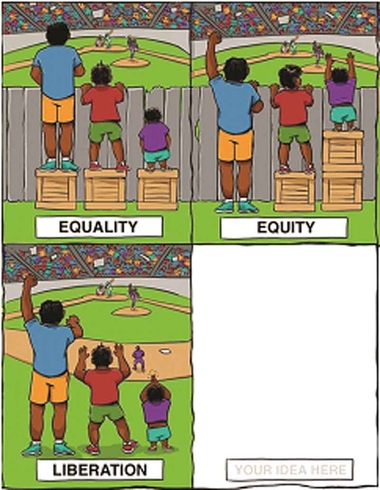Equality vs. equity vs. liberation

by Molly Bryant
Guest Writer
If you’ve been to a diversity and inclusion training in the past couple of years, you may have seen the first two blocks of this graphic highlighting the difference between equality and equity. While it’s a little cheesy and far from a comprehensive explanation, the cartoon does help us separate the ideas of equality and equity.
Equality ensures everyone receives the same rights. Equity means everyone has access to those rights and gets what they need to be successful, considering the systems which don’t treat them the same.
I often participate in anti-oppression, implicit bias and other diversity trainings. One of the most common declarations by well-intentioned and progressive people is they treat everyone the same, regardless of their gender or sexual orientation. I get why this is so common; I truly do.
We believe in the value of equality so strongly we think when we individually treat marginalized populations the same as anyone else, we are doing our due diligence to promote equality. However, when we say this, it says essentially the same thing as the old “I’m colorblind” argument.
While treating everyone the same regardless of who they are feels like a value we should believe in, we need to be able to see color, race, gender expression and identities in order to dismantle systemic oppression. That’s what equity is about.
Put another way, equality is treating everyone fairly and equally. This treatment does not erase disadvantages or privileges, and it does not eliminate historical oppression. It’s a step in the right direction, but it’s not the end goal.
LGBTQ+ rights are an excellent example of equality without equity. Those within the LGBTQ+ community technically have the same civil rights as their heterosexual counterparts, but are all barriers for LGBTQ+ individuals really eliminated the moment our laws become “equal?”
Homophobia and transphobia have not disappeared with the expansion of LGBTQ equality under the law. Hate crimes have not stopped. Harvey Milk’s face has not appeared on our currency. Transwomen of color have not seen a sudden rise in their life expectancy.
Working toward greater equity for marginalized populations can take place on both the systemic and individual levels. In my career as a social worker, I can choose to give the same amount of attention and energy to every client I encounter. Sounds fair, right? It isn’t.
I have some clients who need much more attention and care and creativity and advocacy than others. My white, cisgender client from a middle class background does not have the same needs as my incarcerated, bisexual, Choctaw, single-mother of four. It’s simply not the same, and it would be an injustice to aim for equal care and equal attention.
In the cartoon mentioned earlier, the shortest person is suffering from an inherent quality: shortness. In reality, our metaphorical shortness’s (our marginalized identities) are not inherent disadvantages - they are disadvantages designed and perpetuated by our culture, customs and laws.
When you analyze the cartoon a little more, you’ll realize the biggest structural barrier is the fence, so let’s take an axe to the fence and tear it down piece by piece until we don’t need boxes to stand on to participate fully in the baseball game of life.
Tearing down the fence requires more energy, more attention and a lot more risk. But we want more than equality; we want equity. And we want liberation.
Molly Bryant, MSW is the Underserved Outreach Advocate at Domestic Violence Intervention Services (DVIS) in Tulsa, OK. For domestic violence or sexual assault assistance, please call DVIS at (918) 743-5763 or the National Domestic Violence Hotline at 1 (800)799-7233.
Copyright The Gayly – July 16, 2018 @ 12:55 p.m.CDT.





